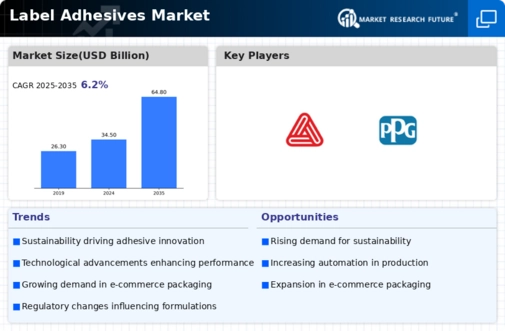Market Trends
Key Emerging Trends in the Label Adhesives Market
The Label Adhesives market has seen considerable adaptation over recent years due to the growing capacity of packaging industry which drives the market. An other most common trend is the increasing requirement of eco-friendly sustainable adhesives for the label. It is demonstrated in environmental consciousness growing among consumers that there is a great need for alternate adhesives which are not only effective but also environmental-friendly ones. Due to the environmental concerns of the customers, manufacturers in the adhesive container market develop formulations that lessen the environmental effects; they use bio-based materials, and adopt the eco-friendly methods of production.
One major trend that structure the market for label adhesives is the growing interest for pressure sensitive adhesives. These adhesives have some useful characteristics; they ease the application process, they can be used with different substrates, and they can be adapted to various situations. With the food and beverage, pharmaceuticals and consumer goods industries still looking for effective and user-friendly labels, the volume of label adhesives need to cope with persistent increment. In haste, these tools are becoming increasingly popular as they simplify application in an effort to speed up the tagging process and therefore enhance overall effectiveness.
On top of this, technological innovations come to intensify the trend changing in bonding market. Progressive implementation of labelling systems, like RFID (Radio-Frequency Identification) and NFC (Near Field Communication) is gaining prominence. This type of technologies improve information access for customers, support traceability and anti-counterfeit measures. With the recognition of value, more businesses start to shift to these smart labeling solutions that are in turn incorporated with label adhesives, a practice that only expands as the technology improves.
Globalization and e-commerce usage growth is one other driving force in the market trend of lable adhesives. Recent progress in the field of logistics and the popularity of e-commerce have given rise to the market need for resilient and secure labeling methods that ensure their durability under demanding circumstances. Labels on packages must be capable to withstand different environmental conditions, unscathed throughout transportation and storage, and stay functional. In addition, the labels that are made to last longer and are resistant against the outdoor conditions are in high demand from the market.
Label adhesives market seems to be a new emerging trigger of growth for the pharmaceutical sector. The scrutiny of pharmaceutical labeling in terms of the product information and safety has increased and has consequently increased the demand for a robust adhesive which complies to these requirements. We are also seeing the rise of specialty drugs production that is in line with the demand growth of label adhesives that guarantee a high-end and safe design.






Leave a Comment